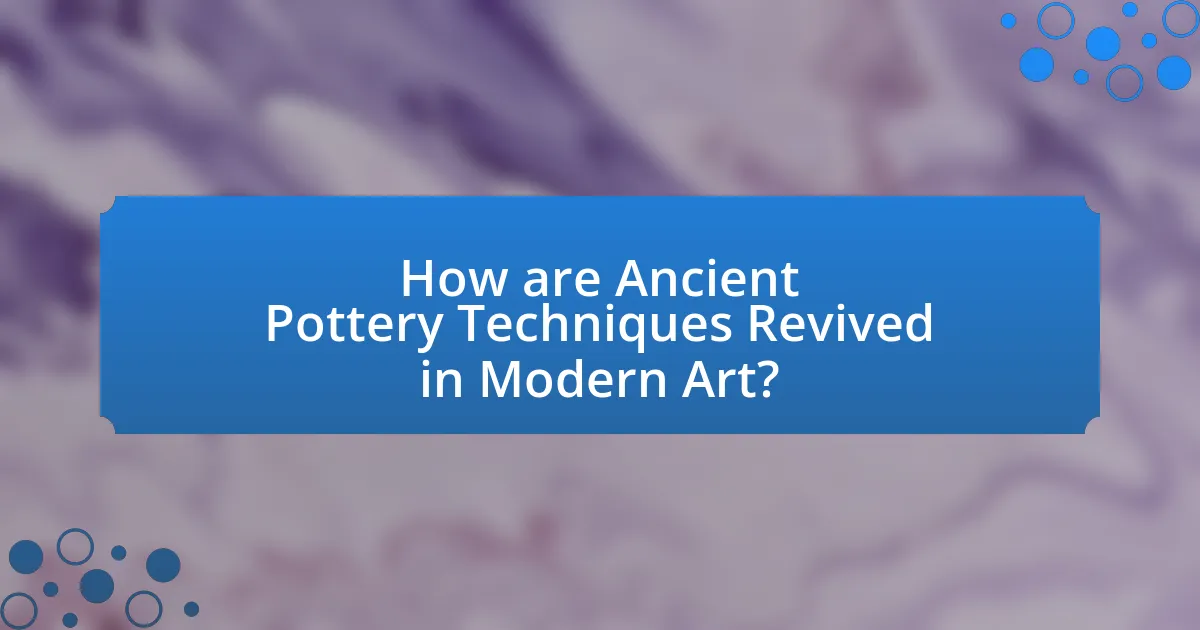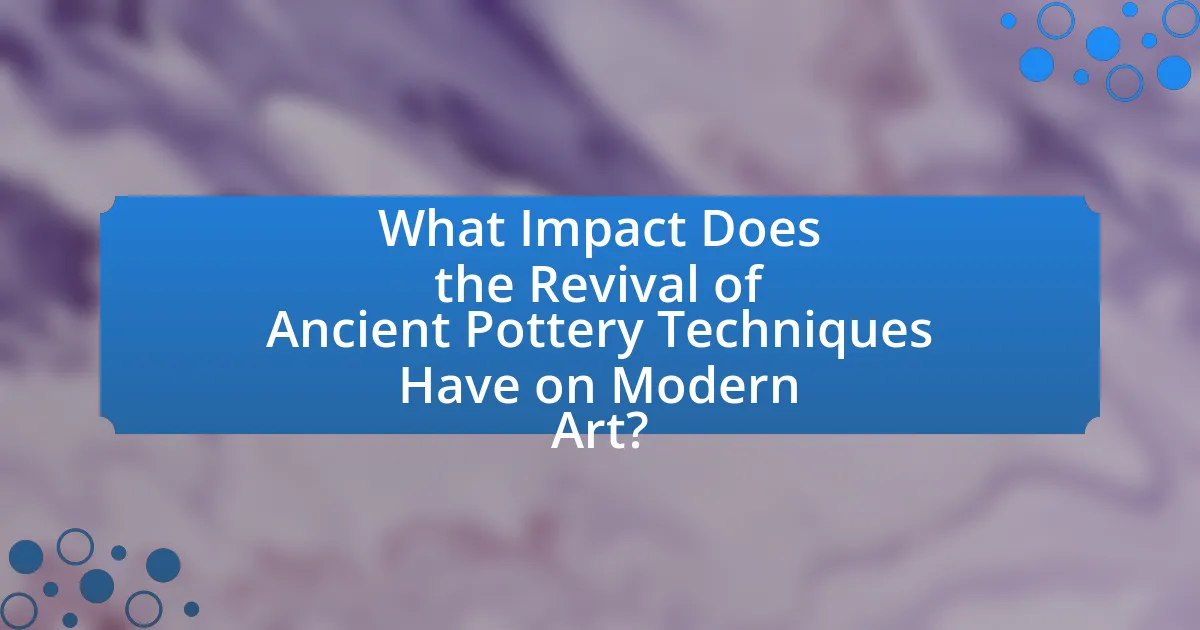The article focuses on the revival of ancient pottery techniques in modern art, highlighting the methods used by early civilizations, such as hand-building and wheel-throwing, as well as firing processes. It explores how ancient cultures developed these techniques through experimentation and environmental influences, and discusses the materials commonly used, including various types of clay and natural additives. The significance of these techniques in art history is examined, along with their reflection of cultural values and practices. Additionally, the article addresses the challenges contemporary artists face when incorporating traditional methods, the impact of this revival on artistic expression, and the broader implications for cultural heritage and preservation.

What are Ancient Pottery Techniques?
Ancient pottery techniques refer to the methods used by early civilizations to create ceramic objects, which include hand-building, wheel-throwing, and firing processes. Hand-building techniques, such as coiling and pinching, allowed artisans to shape clay into various forms without the use of a potter’s wheel, while wheel-throwing, developed around 3500 BCE in Mesopotamia, enabled more uniform and intricate designs. Firing techniques, including pit firing and kiln firing, were crucial for hardening the clay and achieving durability, with evidence of these methods found in archaeological sites dating back thousands of years. The use of specific glazes and decorative techniques, such as slip painting and incising, further exemplifies the sophistication of ancient pottery practices.
How did ancient cultures develop pottery techniques?
Ancient cultures developed pottery techniques through a combination of experimentation with local clay materials and the influence of environmental factors. Early potters discovered that by shaping clay and firing it in kilns, they could create durable vessels for storage and cooking. Archaeological evidence from sites such as Mesopotamia and China indicates that these cultures refined their methods over centuries, leading to advancements in glazing, decorative techniques, and the use of the potter’s wheel around 3500 BCE. This evolution was driven by practical needs, artistic expression, and trade, as pottery became a significant aspect of daily life and cultural identity.
What materials were commonly used in ancient pottery?
Ancient pottery commonly utilized clay, which served as the primary material due to its availability and malleability. Various types of clay, such as earthenware, stoneware, and porcelain, were employed depending on the desired characteristics of the finished product. Additionally, ancient potters often incorporated natural additives like sand, grog (crushed fired clay), and organic materials to enhance the clay’s properties, improve durability, and influence texture. Historical evidence from archaeological sites indicates that these materials were essential in creating functional and decorative pottery across different cultures, including the Greeks, Romans, and Chinese, demonstrating their widespread use and significance in ancient craftsmanship.
What methods were employed in shaping and firing pottery?
Methods employed in shaping pottery include hand-building techniques such as coiling, pinching, and slab construction, as well as wheel-throwing. Coiling involves rolling out clay into long strips and stacking them to form the desired shape, while pinching uses fingers to mold the clay into forms. Slab construction involves rolling out flat pieces of clay and assembling them into structures. Wheel-throwing, on the other hand, utilizes a potter’s wheel to create symmetrical shapes through rotation.
Firing pottery typically involves two main stages: bisque firing and glaze firing. Bisque firing occurs at a lower temperature to harden the clay and remove moisture, while glaze firing follows at a higher temperature to melt the glaze and create a glass-like surface. These methods have been validated through archaeological findings, which show that ancient cultures employed similar techniques, indicating their effectiveness and longevity in pottery-making practices.
Why are ancient pottery techniques significant in art history?
Ancient pottery techniques are significant in art history because they represent foundational methods of artistic expression and cultural identity. These techniques, such as coiling, pinching, and wheel-throwing, not only showcase the technological advancements of their time but also reflect the social, economic, and spiritual values of ancient civilizations. For instance, the intricate designs and forms found in ancient Greek pottery reveal insights into mythology and daily life, while the utilitarian aspects of pottery from cultures like the Native Americans highlight their connection to the environment and community practices. The study of these techniques informs contemporary artists, allowing them to draw inspiration from historical practices and integrate them into modern art, thereby preserving cultural heritage and fostering innovation.
How do these techniques reflect cultural values and practices?
The revival of ancient pottery techniques in modern art reflects cultural values and practices by emphasizing heritage, craftsmanship, and community identity. These techniques often originate from specific cultural traditions, showcasing the historical significance and aesthetic principles valued by those cultures. For instance, the use of traditional glazing methods and hand-building techniques not only preserves the artistry of past generations but also fosters a sense of belonging and continuity within communities. This practice is evident in contemporary artists who draw inspiration from indigenous pottery styles, thereby honoring their cultural roots while adapting them to modern contexts. Such artistic expressions serve as a bridge between past and present, reinforcing the importance of cultural narratives and collective memory in shaping identity.
What role did pottery play in daily life and rituals?
Pottery served essential functions in daily life and rituals by providing practical containers for storage, cooking, and serving food, as well as playing a significant role in ceremonial practices. In ancient societies, pottery was used to create vessels that facilitated the preparation and consumption of meals, which were central to community life. Additionally, pottery often featured symbolic designs and forms that were integral to religious and cultural rituals, such as offerings to deities or burial practices. Archaeological findings, such as the decorated pottery from ancient Mesopotamia and the ceremonial vessels from Mesoamerican cultures, illustrate how pottery was not only functional but also a medium for artistic expression and cultural identity.

How are Ancient Pottery Techniques Revived in Modern Art?
Ancient pottery techniques are revived in modern art through the incorporation of traditional methods, materials, and aesthetics by contemporary artists. Artists often study historical practices, such as hand-building, coiling, and using natural pigments, to create works that reflect ancient cultures while addressing modern themes. For example, the use of pit firing, a technique dating back thousands of years, is employed by artists to achieve unique surface textures and colors that resonate with historical significance. This revival not only preserves cultural heritage but also fosters a dialogue between past and present, as seen in exhibitions that showcase works inspired by ancient civilizations, such as the Minoan or Native American pottery styles.
What motivates contemporary artists to revive these techniques?
Contemporary artists are motivated to revive ancient pottery techniques primarily to reconnect with cultural heritage and explore traditional craftsmanship. This revival allows artists to infuse their work with historical significance, creating a dialogue between past and present. For instance, the use of ancient glazing methods can enhance the aesthetic quality of modern ceramics, while also paying homage to the artisans of previous eras. Additionally, artists often seek to challenge contemporary notions of art by integrating time-honored practices, thereby fostering a deeper appreciation for the skills and narratives embedded in these techniques.
How do artists incorporate ancient methods into their work?
Artists incorporate ancient methods into their work by utilizing traditional techniques and materials that have historical significance. For example, many contemporary ceramicists adopt ancient pottery methods such as coiling, pinching, and slab building, which were used by cultures like the Greeks and Native Americans. This revival not only preserves these techniques but also allows artists to explore cultural narratives and craftsmanship that connect modern audiences to historical practices. The use of natural pigments and firing methods, such as pit firing, further enhances the authenticity and aesthetic of the artwork, reflecting a deep respect for the origins of these techniques.
What challenges do artists face when using traditional techniques?
Artists face several challenges when using traditional techniques, including limited access to materials, time-consuming processes, and the need for specialized skills. Limited access to authentic materials, such as specific clays or natural pigments, can hinder the ability to replicate ancient methods accurately. Additionally, traditional techniques often require extensive time investment, as processes like hand-building or firing in a kiln can be labor-intensive and lengthy. Furthermore, artists must possess specialized skills that may not be widely taught or practiced today, making it difficult to master these techniques. These challenges can impact the overall quality and authenticity of the artwork produced.
In what ways do modern interpretations differ from ancient practices?
Modern interpretations of ancient pottery techniques differ significantly from ancient practices in their use of materials, technology, and artistic intent. While ancient potters primarily utilized locally sourced clay and natural pigments, modern artists often incorporate synthetic materials and advanced glazing techniques to enhance durability and aesthetic appeal. Additionally, ancient pottery was typically functional, serving everyday purposes, whereas contemporary interpretations frequently prioritize artistic expression and conceptual themes over utility. This shift is evidenced by the rise of ceramic art as a medium for personal and political statements, contrasting with the communal and practical focus of ancient pottery.
How do contemporary artists innovate while respecting tradition?
Contemporary artists innovate while respecting tradition by integrating ancient pottery techniques into modern artistic practices. They often study historical methods, such as coiling and glazing, and adapt these techniques to create contemporary works that reflect current themes and aesthetics. For instance, artists like Magdalene Odundo blend traditional African pottery styles with modern forms, resulting in pieces that honor cultural heritage while pushing artistic boundaries. This approach not only preserves the techniques but also revitalizes them, making them relevant in today’s art scene.
What new materials or technologies are being integrated?
New materials and technologies being integrated into the revival of ancient pottery techniques include high-temperature ceramics, eco-friendly glazes, and digital fabrication methods. High-temperature ceramics allow for greater durability and heat resistance, enhancing the functionality of pottery. Eco-friendly glazes, made from natural minerals, promote sustainability and reduce environmental impact. Digital fabrication methods, such as 3D printing, enable precise replication of traditional designs while allowing for innovative adaptations. These advancements reflect a blend of historical craftsmanship with contemporary practices, ensuring the relevance of ancient techniques in modern art.

What Impact Does the Revival of Ancient Pottery Techniques Have on Modern Art?
The revival of ancient pottery techniques significantly influences modern art by reintroducing traditional craftsmanship and cultural narratives into contemporary practices. This resurgence allows artists to explore historical methods, such as hand-building and glazing techniques used in ancient civilizations, which fosters a deeper connection to cultural heritage. For instance, artists like Magdalene Odundo incorporate African pottery traditions into their work, blending them with modern aesthetics, thereby enriching the narrative and visual language of contemporary art. Additionally, the use of ancient techniques often emphasizes sustainability and the value of handmade objects in an increasingly industrialized world, as seen in the works of artists who prioritize eco-friendly materials and processes. This impact is evident in exhibitions that showcase the fusion of ancient and modern styles, highlighting the ongoing dialogue between past and present in the art world.
How does this revival influence artistic expression and creativity?
The revival of ancient pottery techniques significantly influences artistic expression and creativity by reintroducing traditional methods that inspire contemporary artists. This resurgence allows artists to explore historical craftsmanship, leading to innovative interpretations and unique aesthetic outcomes. For instance, the use of hand-building techniques and natural glazes, which were prevalent in ancient cultures, encourages artists to experiment with texture and form, resulting in distinctive works that reflect both heritage and modern sensibilities. Additionally, this revival fosters a deeper connection to cultural narratives, as artists incorporate storytelling elements from ancient practices into their contemporary works, enriching the overall artistic landscape.
What themes or messages are conveyed through revived techniques?
Revived techniques in modern art convey themes of cultural heritage, sustainability, and the intersection of tradition and innovation. These techniques often reflect a deep respect for historical craftsmanship, emphasizing the importance of preserving cultural identities in a rapidly changing world. For instance, artists utilizing ancient pottery methods highlight the value of sustainable practices, as many traditional techniques are inherently eco-friendly, relying on natural materials and processes. Additionally, the blending of old and new methods illustrates a dialogue between past and present, showcasing how contemporary artists reinterpret historical practices to create relevant and meaningful works today. This approach not only honors the legacy of ancient artisans but also invites viewers to engage with the ongoing evolution of artistic expression.
How does the revival affect the perception of pottery as an art form?
The revival of ancient pottery techniques significantly enhances the perception of pottery as a legitimate art form. This resurgence emphasizes craftsmanship, creativity, and cultural heritage, positioning pottery alongside other fine arts. For instance, exhibitions showcasing contemporary artists who utilize traditional methods, such as those seen in the works of artists like Grayson Perry, demonstrate that pottery can convey complex narratives and aesthetic values, thereby elevating its status in the art world. Additionally, the integration of pottery into modern art movements, such as the studio pottery movement, further validates its artistic significance, as it encourages innovation while respecting historical practices.
What are the broader implications for cultural heritage and preservation?
The broader implications for cultural heritage and preservation include the revitalization of traditional craftsmanship and the promotion of cultural identity. The revival of ancient pottery techniques in modern art not only fosters a connection to historical practices but also encourages communities to value and maintain their cultural heritage. This is evidenced by initiatives that document and teach these techniques, ensuring that knowledge is passed down through generations, as seen in various cultural preservation programs worldwide. Such efforts contribute to a greater appreciation of diversity in artistic expression and the importance of safeguarding intangible cultural heritage, as recognized by UNESCO’s 2003 Convention for the Safeguarding of the Intangible Cultural Heritage.
How does the revival contribute to the understanding of historical contexts?
The revival of ancient pottery techniques enhances the understanding of historical contexts by providing insights into the cultural, social, and technological practices of past civilizations. This revival allows contemporary artists and historians to analyze the methods and materials used in ancient pottery, revealing information about trade routes, local resources, and artistic influences. For example, the use of specific clay types and firing techniques can indicate regional differences and technological advancements, thereby contextualizing the pottery within its historical timeline. Additionally, the revival fosters a dialogue between past and present, illustrating how ancient practices inform modern artistic expressions and cultural identities.
What role does community engagement play in this revival?
Community engagement plays a crucial role in the revival of ancient pottery techniques in modern art by fostering collaboration between artists, historians, and local communities. This collaboration enhances the transmission of traditional knowledge and skills, ensuring that ancient methods are preserved and adapted for contemporary use. For instance, workshops and community events allow artisans to share techniques with younger generations, creating a living tradition that evolves while maintaining its roots. Research indicates that community-driven initiatives can increase participation in cultural practices, leading to a more vibrant and sustainable artistic community.
What are some best practices for artists interested in ancient pottery techniques?
Artists interested in ancient pottery techniques should prioritize studying historical methods and materials used by ancient cultures. This involves researching specific pottery styles, such as those from the Minoan, Greek, or Native American traditions, to understand their unique characteristics and techniques. Additionally, artists should practice traditional hand-building methods, such as coiling and pinching, which were commonly used before the advent of the potter’s wheel.
Using authentic materials, like natural clay and mineral-based glazes, can enhance the authenticity of the work. Engaging with workshops or mentorships led by experts in ancient pottery can provide hands-on experience and deeper insights into these techniques. Furthermore, documenting the process and experimenting with variations can lead to a personal interpretation of ancient styles while respecting their origins.
These practices are supported by the resurgence of interest in traditional crafts, as evidenced by the growing number of workshops and exhibitions dedicated to ancient pottery techniques, highlighting their relevance in contemporary art.
How can artists effectively learn and master these techniques?
Artists can effectively learn and master ancient pottery techniques through hands-on practice, mentorship, and studying historical methods. Engaging in workshops led by experienced artisans allows artists to gain practical skills and insights into traditional practices. Additionally, analyzing ancient pottery artifacts in museums provides context and inspiration, helping artists understand the cultural significance and technical details of these techniques. Research indicates that immersive learning experiences, such as apprenticeships, significantly enhance skill acquisition in craft-based disciplines, as evidenced by studies in vocational education.
What resources are available for artists exploring ancient pottery methods?
Artists exploring ancient pottery methods can access a variety of resources, including academic journals, workshops, and online courses. Academic journals such as “The Journal of Archaeological Science” provide research on ancient techniques and materials, while workshops offered by institutions like the American Craft Council teach hands-on skills in traditional pottery methods. Additionally, online platforms like Coursera and Skillshare offer courses specifically focused on ancient pottery techniques, allowing artists to learn at their own pace. These resources collectively support the revival of ancient pottery techniques in modern art by providing both theoretical knowledge and practical skills.


